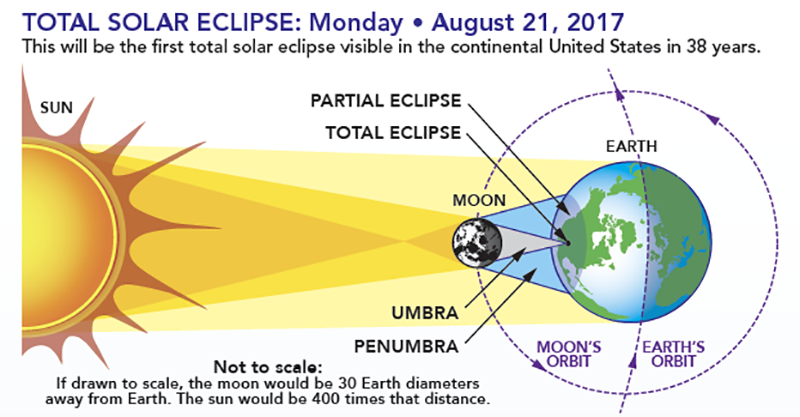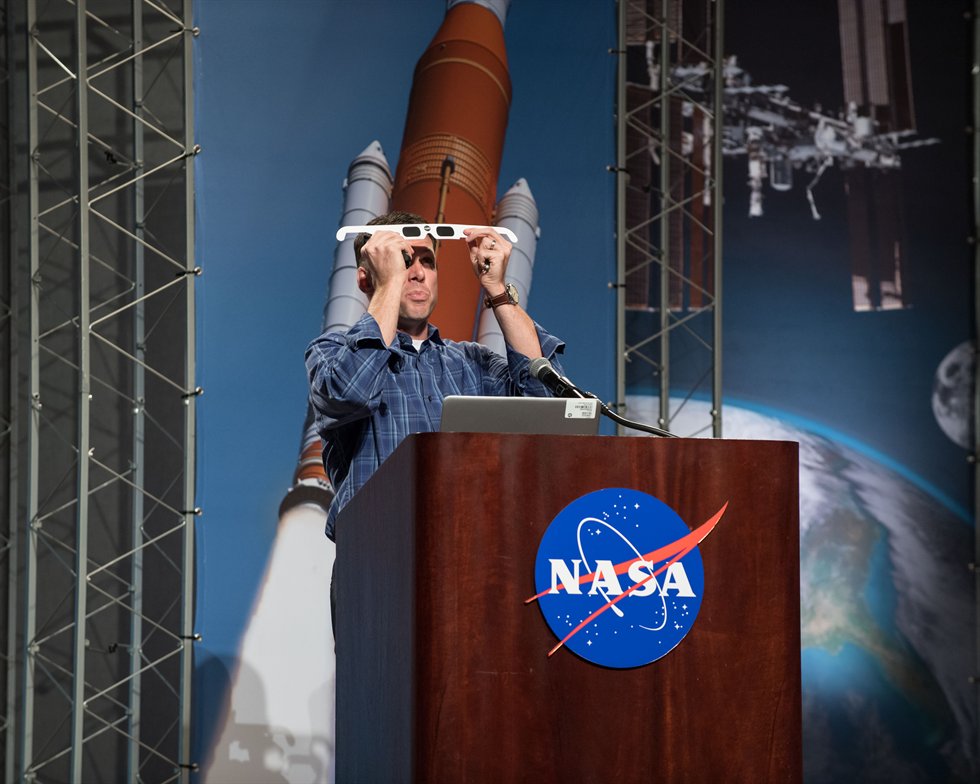10 things to know (and share) about the Eclipse Across America
Despite the moon’s best efforts this Aug. 21 to downgrade the sun’s status as “center of the universe” by blocking its dynamic rays, all eyes will be on this rare astronomical event as a total solar eclipse seemingly follows the interstate highway system of North America.
On Aug. 15, NASA’s Johnson Space Center brought in experts Dr. Mark Matney, JSC space debris scientist, astronomer and planetary scientist, and Dr. Tyson Brunstetter, U.S. Navy optometrist, to brief Johnson team members about the most important things to know about the Eclipse Across America. While Brunstetter focused on viewing safety, Matney offered a plethora of interesting factoids and information about what to expect from this solar phenomenon. Dave Draper, manager of the Astromaterials Research and Exploration Science Office, emceed the event.
Here are some of the top 10 things they talked about that you should know (and possibly share) with your friends and family before the big day.
1. For those of us in Houston, the best time to view the solar eclipse will be 1:17 p.m.
However, as indicated by an overwhelming show of hands, a good portion of the workforce will be hitting the highways to chase the eclipse from the comfort of their cars and lawn chairs. Truthfully, we would not have expected any less.
2. Kids 10 and under are most prone to staring at the sun without proper eye protection.
We may be preaching to the choir here about eye safety, but hopefully you can pass along safe viewing tips to the little ones in your midst the day of.
3. The eye has about 125 million photoreceptors sandwiched in it.
This, consequently, leaves no room for pain sensors within the eye. If not viewing the eclipse properly, you could essentially burn your retina and have no idea you have done anything amiss.
4. Despite our scaremongering, you can look at the total solar eclipse with the naked eye.
But—and there are a ton of caveats here—unless you’re in the sweet spot on the map where the eclipse will be “total,” we take back what we said. Plus, for those even in that dark strip on the map where the eclipse will eventually become total, please don’t do this until the moon is entirely covering up the sun. Everyone in Houston, though, please heed our warning and wear the eclipse viewing glasses.
5. Your eclipse viewing glasses could be fake and not certified to prevent eye damage.
This, unfortunately, is true. There are unscrupulous merchants who are selling glasses that are not the real deal, so ensure yours are from a reputable vendor before you turn your eyes to the sky.
6. A pinhole is actually a universal lens.
You don’t just have to have reliable eclipse viewing glasses to enjoy what the sun (and moon) has in store. A good old-fashioned pinhole can allow you to join in the festivities. Consider a fun activity for the kids: View the eclipse using an ordinary cereal box.
“It’s great for the kids, it’s fun to build and they’ll be facing away from the sun,” Brunstetter said.
7. The moon and Earth aren’t aligning all the time because the moon’s orbit is tilted about 5 percent on the Earth/sun plane.
Solar eclipses of any sort happen only three to five times a year around the world. It’s a rare enough occurrence, thanks to the moon’s slightly off orbit, that we all can look forward to them with great relish.
8. The sun is 400 times larger than the moon, but also almost 400 times farther away.
See, kids, math can be good. This cool calculation within the solar system allows what Matney called a “diamond ring effect” as sun’s corona seemingly encircles the moon during totality.
9. A total solar eclipse can give you a chance to see the usual suspect planets—including even Mercury.
As darkness envelopes certain spots in the United States, some lucky folks will get to glimpse the stars and planets make an appearance, allowing for some neat astronomy.
10. This is your chance to be a citizen scientist.
For those of us at Johnson and beyond who aren’t scientists in our everyday lives, the solar eclipse is a great opportunity for us to marvel at an astronomical event that has entranced people since ancient times.
Matney suggested that kids—and adults—make their own scientific observations.
“Does the temperature start to go down? Animals behave strangely? Also watch other human beings; they behave strangely, too,” Matney joked.
11. Because we have a gratuitous fact to throw in.
If, by chance, you miss this total solar eclipse, just hope you can be around—and available—in April 2024 for the next total solar eclipse in the United States.
On second thought, just be sure to make this one. Less complicated that way.
Share in the conversation on social media with #eclipse2017.
Don’t know enough yet about the eclipse? That’s OK. We have a website: eclipse2017.nasa.gov
Again, here’s an American Astronomical Society resource that lists verified safe eclipse glasses manufacturers/vendors. Don’t look up without it.
Would you rather not brave the outdoors (and heat) to see what the cosmos has to offer? NASA is offering a livestream of the eclipse here. 
Diagram showing the Earth-sun-moon geometry of a total solar eclipse. Not to scale. If drawn to scale, the moon would be 30 Earth diameters away. The sun would be 400 times that distance.
Catherine Ragin Williams
NASA Johnson Space Center












